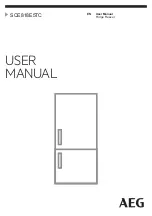
16
5
Before disposing of old appliances make them unusable. Remove plug
from mains, sever the power cable, remove or destroy any snap or latch
closures. This eliminates the danger of playing children locking
themselves into the appliance (danger of suffocation) or place
themselves into other life-endangering situations.
Children often do not recognise the dangers involved with household
appliances. Please provide for the necessary supervision and do not
allow children to play with the appliance!
Daily Operation
Containers with flammable gases or fluids can develop leaks through
contact with the cold, they may even explode. Do not store containers
with flammable substances, such as aerosol cans, refill cartridges for
cigarette lighters etc. in the freezer.
Bottles and cans may not be placed in the freezer compartment. They
can burst when the contents freeze - or even explode if the contents
contain carbonic acid Never place sodas, juices, beer, wine,
champagne etc. into the freezer compartment. Exception: Spirits with
high alcohol content may be stored in the freezer compartment.
Do not place ice cream or ice cubes directly from the freezer
compartment into the mouth. Very cold ice can freeze to the lips or
tongue and cause injury.
Never touch frozen goods with wet hands. Hands can freeze to the
goods.
Do not operate any electrical appliances in the freezer (e.g. electric ice
cream makers, mixers etc.).
Before cleaning the appliance always disconnect the appliance from
the electricity supply.
When unplugging always pull the plug from the mains socket, do not
pull on the cable.
In case of malfunction
If a malfunction occurs on the appliance, please look first in the "What
to do if ..." section of these instructions. If the information given there
does not help, please do not perform any further repairs yourself.
This product should be serviced by an authorised engineer and only
genuine spare parts should be used.
Under no circumstances should you attempt to repair the appliance
yourself. Repairs carried out by inexperienced persons may cause injury
or serious malfunctioning. Contact your local AEG Service Force Centre.
F
F
Defrost the freezer compartment (see section: "Defrosting").
F
F
Clean the appliance and the interior accessories with a cloth and
lukewarm water. Commercially available dish washing detergents may also
be used.
F
F
After cleaning wipe with fresh water and rub dry.
Attention!
Reinsert the plug of the defrost water outlet at the base of the
freezer after cleaning.
F
F
After everything is dry place appliance back into service.
Energy Saving Tips
Do not install the appliance near cookers, radiators or other sources of
warmth. High ambient temperatures cause longer, more frequent
operation of the compressor.
In order to guarantee sufficient ventilation, do not cover or obstruct the
sides and base of the appliance.
Do not place warm foods into the appliance. Allow warm foods to cool
first.
Do not leave the lid open any longer than necessary.
Do not set the temperature colder than necessary.
Place frozen goods into the refrigerator for thawing. Cold from frozen
goods is thus used for cooling in the refrigerator.
What to do if ...
Correcting Malfunctions
A malfunction may be caused by only a minor fault that you can rectify
yourself using the following instructions.
Please check whether the pilot lights come on, the refrigerating unit
operates, and the internal temp
er
ature is being maintained. Do not
perform any other work on the appliance if the following information does
not provide assistance in your specific case.
Warning!
Repairs to refrigerators/freezers may only be performed by
competent service engineers. Improper repairs can give rise to significant
hazards for the user. If your appliance needs repairing, please contact
your specialist dealer or your Local Service Force Centre.
♣




























